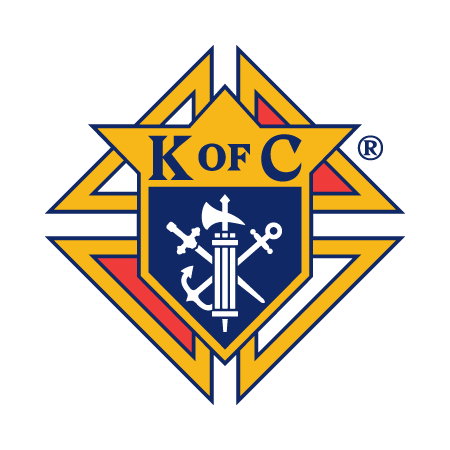Knights of New Brunswick: An Historical outline 1904 - 2001
"The storm arrived overnight" screamed the headlines in the Saint John Globe on Monday November 14, 1904. Over night, great wind accompanied by rain, sleet and snow interrupted telegraph service. Lines were down all over the country. All trains were running late by as much as five hours. It was a memorable day because the storm also brought with it members of the Knights of Columbus to Saint John from Eastport, Bangor, Boston and other points to institute the Saint John Council. The Globe on Tuesday November 15 headlined "the morning train brought many knights from Maine and Massachusetts".
The New York Times for November 14, 1904 said "New York was almost entirely cut off from communication." The whole eastern seaboard of the U.S. and the Maritime Provinces were badly trashed. There is an old saying, however, that some good comes from every ill. In the wake of a very destructive storm, one of the worst in memory, the Knights of Columbus was born in New Brunswick with Council 937. Today, there are 125 councils; the work of those councils has made a big difference for the Catholic Church and all humanity here.
It was on October 2, 1881 in the basement of St. Mary's Church on Hillhouse Avenue, New Haven, Connecticut that Father Michael McGivney called the first meeting to order to discuss the feasibility of establishing an organization along the lines of a fraternal benefit society. Under the firm direction of Father McGivney, the Knights of Columbus was formed on March 29, 1882, the date that is now traditionally known as the organization's 'founder's day.
Historically, the Knights of Columbus has strong ties to Canada. In 1868, a young Michael McGivney commenced a two-year preparation for entrance to the seminary when he enrolled at the College of St. Hyacinth in Quebec. The school records for 1869 show he has awarded the prize for excellence in English as well as honorable mention in Latin translation and grammar. A second historical tie to Canada is directly to New Brunswick. Bishop Lawrence S. McMahon, Ordinary of the Hartford Connecticut diocese, granted Father McGivney permission to proceed with the establishment of the Knights of Columbus. Bishop McMahon, who was born in Saint John, was a strong supporter of the movement, and when a council was formed in Hartford, he became its first chaplain.
The first council in Canada was Montreal in 1898. The first council in the Maritimes was in Charlottetown in 1903 followed by Saint John. This province is fast moving toward 100 years of Colombianisme. Charter date for Council 937 in November 14, 1904. At that time, the Saint John council had members from all over the province. In fact, Bishop Timothy Casey, the bishop of the day, would not permit the council to be formed in Saint John unless membership was open to all Catholic men in New Brunswick.
By the spring of 1907, Miramichi Council No. 1219 was formed in Chatham. One of the charter members of Council 937 was largely responsible for the Miramichi Council and became its first grand knight. In May of 1908, Moncton Council 1310 was launched. There were no more council in New Brunswick until 1919 when Edmundston, Bathurst, Campbellton, and Fredericton got their charters. In 1921, Woodstock and Grand Falls formed councils. From 1921 until 1971 only nine councils were formed. But the expansion boom commenced in the '70s. In the 1971 - 1983 period 67 councils were formed throughout the province, and progress has continued to reach today's total of 125. Initially, Council 937 came under the state jurisdiction of Ontario and Quebec, but by 1905 the State Council for the Maritime Provinces of Canada and Newfoundland was established. In January 1914, it was changed to State Council for the Maritime Provinces of Canada, and in 1921, New Brunswick State Council was established.
Knights of Columbus in New Brunswick were honored by visits from five supreme knights. Supreme Knight James J. Flatherly visited all three councils here in 1916 and gave a talk to each. The New Freeman (October 7, 1916) said of his talk at Saint John: He was "Warmly received and gave an interesting speech of an hour and a half, dealing with some of the features of the work of the order. He referred particularly to the labor of the advancement of education." When Supreme Knight Martin Carmody talked in Saint John in June 1931, he "gave one of the finest addresses yet heard in Saint John and had the close attention of those present for more than an hour". Carmody visited several councils in the Maritimes, including Moncton.
The third visit was by Supreme Knight Francis Matthews when he came to the Maritimes for the 40th anniversary of the Charlottetown Council in 1943. Matthews returned a few weeks before from "a trip by bomber to the British Isles where he visited the Knights of Columbus Army Huts serving our armed forces there". When he spoke at both Saint John and Moncton, he had great praise for what our Knights were doing at home and in the front lines.
Other supreme knights that visited New Brunswick were John McDevitt in mid-1975 and Virgil Dechant in 1981 and in May 1999. Dechant received an honorary degree from St. Thomas University on his second visit.
The Knights of Columbus has a long history of much activity for both church and community life throughout New Brunswick. That history, which will record details of the Army Huts during World War 1 and 11; a child adoption program of the 1930; and Add-a-child of the 1970s; youth programs especially scholarships; Camp Sheldrake; and numerous other projects is now being compiled for the 100th anniversary.
